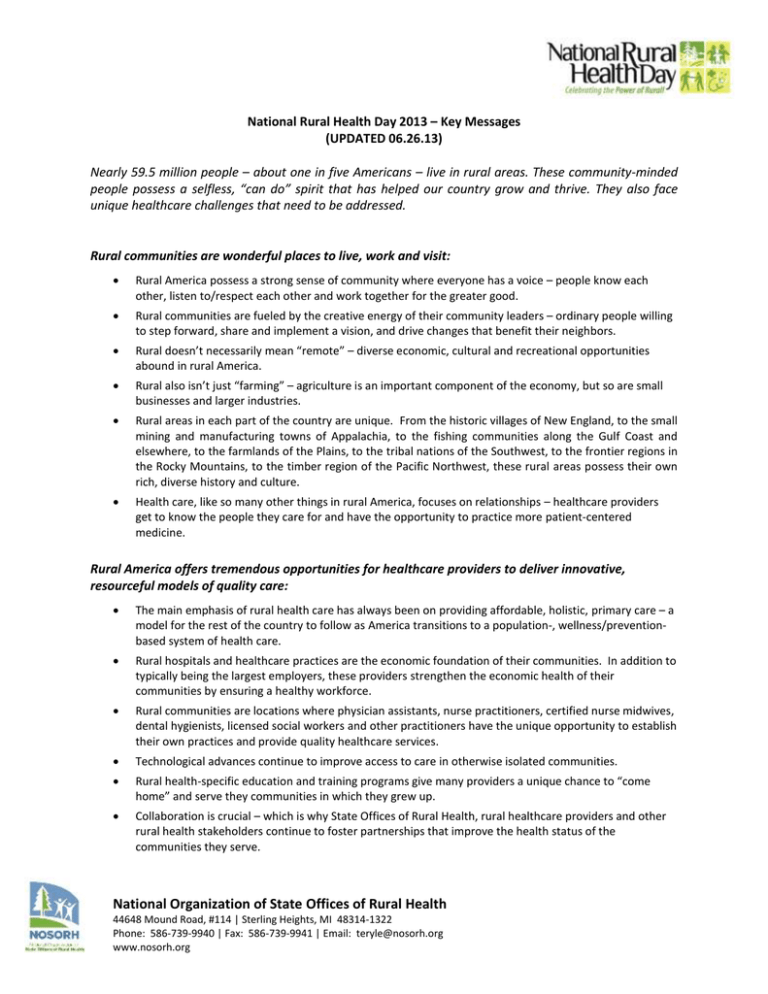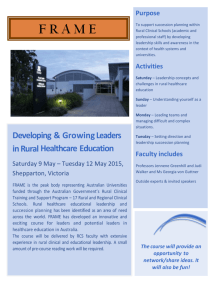National Rural Health Day 2013 – Key Messages (UPDATED 06.26
advertisement

National Rural Health Day 2013 – Key Messages (UPDATED 06.26.13) Nearly 59.5 million people – about one in five Americans – live in rural areas. These community-minded people possess a selfless, “can do” spirit that has helped our country grow and thrive. They also face unique healthcare challenges that need to be addressed. Rural communities are wonderful places to live, work and visit: Rural America possess a strong sense of community where everyone has a voice – people know each other, listen to/respect each other and work together for the greater good. Rural communities are fueled by the creative energy of their community leaders – ordinary people willing to step forward, share and implement a vision, and drive changes that benefit their neighbors. Rural doesn’t necessarily mean “remote” – diverse economic, cultural and recreational opportunities abound in rural America. Rural also isn’t just “farming” – agriculture is an important component of the economy, but so are small businesses and larger industries. Rural areas in each part of the country are unique. From the historic villages of New England, to the small mining and manufacturing towns of Appalachia, to the fishing communities along the Gulf Coast and elsewhere, to the farmlands of the Plains, to the tribal nations of the Southwest, to the frontier regions in the Rocky Mountains, to the timber region of the Pacific Northwest, these rural areas possess their own rich, diverse history and culture. Health care, like so many other things in rural America, focuses on relationships – healthcare providers get to know the people they care for and have the opportunity to practice more patient-centered medicine. Rural America offers tremendous opportunities for healthcare providers to deliver innovative, resourceful models of quality care: The main emphasis of rural health care has always been on providing affordable, holistic, primary care – a model for the rest of the country to follow as America transitions to a population-, wellness/preventionbased system of health care. Rural hospitals and healthcare practices are the economic foundation of their communities. In addition to typically being the largest employers, these providers strengthen the economic health of their communities by ensuring a healthy workforce. Rural communities are locations where physician assistants, nurse practitioners, certified nurse midwives, dental hygienists, licensed social workers and other practitioners have the unique opportunity to establish their own practices and provide quality healthcare services. Technological advances continue to improve access to care in otherwise isolated communities. Rural health-specific education and training programs give many providers a unique chance to “come home” and serve they communities in which they grew up. Collaboration is crucial – which is why State Offices of Rural Health, rural healthcare providers and other rural health stakeholders continue to foster partnerships that improve the health status of the communities they serve. National Organization of State Offices of Rural Health 44648 Mound Road, #114 | Sterling Heights, MI 48314-1322 Phone: 586-739-9940 | Fax: 586-739-9941 | Email: teryle@nosorh.org www.nosorh.org Despite these opportunities, barriers remain: Addressing the shortage of healthcare providers is one of the greatest health issues – and one of the greatest economic issues – facing Rural America today. While the Affordable Care Act may make health care more affordable for rural Americans, it doesn’t necessarily make it more accessible – a lack of public transportation, fragile infrastructures, and geographic barriers must be addressed in order to ensure that all safety net providers can adequately meet the basic healthcare needs of the residents they serve. Improving access to ambulatory/emergency medical services is especially critical in rural America, where 20% of the nation’s population lives but nearly 60% of all trauma deaths occur. Despite some technological advances, improving access to broadband and telecommunications services is a crucial investment that must be made in order to improve the economic health of rural communities and the physical health of their citizens. Designing programs and building support systems that develop and nurture creative, committed community leaders is essential for improving the overall health and well-being of rural communities and their residents. The healthcare needs of rural citizens are as unique as the communities in which they live. Those needs cannot be addressed by utilizing a generic “one size fits all” approach – programs and policies must be flexible enough to allow rural communities to identify and address the unique needs of their residents.





